Tamilnadu State Board New Syllabus Samacheer Kalvi 11th Bio Zoology Guide Pdf Chapter 9 Locomotion and Movement Text Book Back Questions and Answers, Notes.
Tamilnadu Samacheer Kalvi 11th Bio Zoology Guide Chapter 9 Locomotion and Movement
11th Bio Zoology Guide Locomotion and Movement Text Book Back Questions and Answers
Part I
Question 1.
Muscles are derived from
a) ectoderm
b) mesoderm
c) endoderm
d) neuro ectoderm
Answer:
b) mesoderm
Question 2.
Muscles are formed by
a) myocytes
b) leucocytes
c) osteocytes
d) lymphocytes
Answer:
a) myocytes
![]()
Question 3.
The muscles attached to the bones are called
a) skeletal muscle
b) cardiac muscle
c) involuntary muscle
d) smooth muscles
Answer:
a) skeletal muscle
Question 4.
Skeletal muscles are attached to the bones by
a) tendon
b) ligament
c) pectin
d) fibrin
Answer:
a) tendon
![]()
Question 5.
The bundle of muscle fibres is called
a) Myofibrils
b) fascicle
c) sarcomere
d) sarcoplasm
Answer:
b) fascicle
Question 6.
The pigment present in the muscle fibre to store oxygen is
a) myoglobin
b) troponin
c) myosin
d) actin
Answer:
a) myoglobin
![]()
Question 7.
The functional unit of a muscle fibre is
a) sarcomere
b) sarcoplasm
c) myosin
d) actin
Answer:
a) sarcomere
Question 8.
The protein present in the thick filament is
a) myosin
b) actin
c) pectin
d) leucin
Answer:
a) myosin
![]()
Question 9.
The protein present in the thin filament is
a) myosin
b) actin
c) pectin
d) leucin
Answer:
b) actin
Question 10.
The region between two successive Z-discs is called a
a) sarcomere
b) microtubule
c) myoglobin
d) actin
Answer:
a) sarcomere
![]()
Question 11.
Each skeletal muscle is covered by
a) epimysium
b) perimysium
c) endomysium
d) hypomysium
Answer:
a) epimysium
Question 12.
Knee joint is an example of
a) saddle joint
b) hinge joint
c) pivot joint
d) gliding joint
Answer:
b) hinge joint
![]()
Question 13.
Name of the joint present between the atlas and axis is
a) synovial joint
b) pivot joint
c) saddle joint
d) hinge joint
Answer:
b) pivot joint
Question 14.
ATPase enzyme needed for muscle contraction is located in
a) actinin
b) troponin
c) myosin
d) actin
Answer:
c) myosin
![]()
Question 15.
Synovial fluid is found in
a) Ventricles of the brain
b) Spinal cord
c) immovable joint
d) freely movable joints
Answer:
d) freely movable joints
Question 16.
Inflammation of joints due to accumulation of uric acid crystals is called as
a) Gout
b) myasthenia gravis
c) osteoporosis
d) osteomalacia
Answer:
a) Gout
![]()
Question 17.
Acetabulum is located in
a) collar bone
b) hip bone
c) shoulder bone
d) thigh bone
Answer:
b) hip bone
Question 18.
Appendicular skeleton is
a) girdles and their limbs
b) vertebrae
c) skull and vertebral column
d) ribs and sternum
Answer:
a) girdles and their limbs
![]()
Question 19.
The type of movement exhibits by the macrophages are
a) flagellar
b) ciliary
c) muscular
d) amoeboid
Answer:
d) amoeboid
Question 20.
The pointed portion of the elbow is
a) acromion process
b) glenoid cavity
c) olecranon process
d) symphysis
Answer:
c) olecranon process
![]()
Question 21.
Name the different types of movement
Answer:
- Amoeboid movement
- Ciliary movement
- Flagellar movement
- Muscular movement
Question 22.
Name the filaments present in the Sarcomere.
Answer:
Thick and thin filaments are the two types of filaments present inside the sarcomere.
Question 23.
Name the contractile proteins present in the skeletal muscle.
Answer:
- Myosin – Thick filament
- Actin – Thin filament
Question 24.
When describing a skeletal muscle. What does “Striated mean?
Answer:
Each skeletal muscle fibre has a repeated series of dark and light bands. The dark A-bands and light I-bands give a striated appearance to the muscle.
![]()
Question 25.
How does an isotonic contraction takes place?
Answer:
In isotonic contraction, the length of the muscle changes but the tension remains constant.
(eg) lifting dumbbells and weight lifting.
Question 26.
How does an isometric contraction take place?
Answer:
In isotonic contraction, the length of the muscle changes but the tension remains constant. The force produced is unchanged, e.g., lifting dumbbells and weight lifting.
Question 27.
Name the bones of the skull.
Answer:
The cranial bones are 8 in number.
- Paired parietal
- Paired temporal
- frontal
- Sphenoid
- Occipital
- Ethmoid
Question 28.
Which is the only jointless bone in the human body?
Answer:
The jointless bone is the hyoid bone in our throat. The hyoid bone (lingual bone) is a horseshoe.
Question 29.
List the three main parts of the axial skeleton.
Answer:
- Cranium
- Hyoid (Lingual)
- Vertebral column
- Thoracic cavity.
Question 30.
How is tetany caused?
Answer:
Due to the deficiency of parathyroid hormone the level of calcium decreases in the blood that leads to rapid muscle spasm called tetany.
![]()
Question 31.
How does rigor mortis happen?
Answer:
After the death of an individual, the membrane of muscle cells becomes more permeable to calcium ions. This happens due to the partial contraction of skeletal muscles. The contracted muscles are unable to relax. This condition is known as rigor mortis.
Question 32.
What are the different types of rib bones that form the rib cage?
Answer:
- True rib bones (First 7 pairs)
- False rib bones (8,9,10th pairs)
- Floating rib bones (11 and 12th pair)
Question 33.
What are the bones that make the pelvic girdle?
Answer:
- Ilium
- Ischium
- Pubis
Question 34.
List the disorders of the muscular system.
Answer:
- Muscle fatigue
- Atrophy
- Muscle pull
- Muscular dystrophy
Arthritis
- Osteoarthritis
- Rheumatoid arthritis
- Gout
Question 35.
Explain the sliding-filament theory of muscle contraction.
Answer:
Sliding filament theory is an active process. It is proposed by Andrw F. Huxley in 1954 and Rolf Niedergerke.
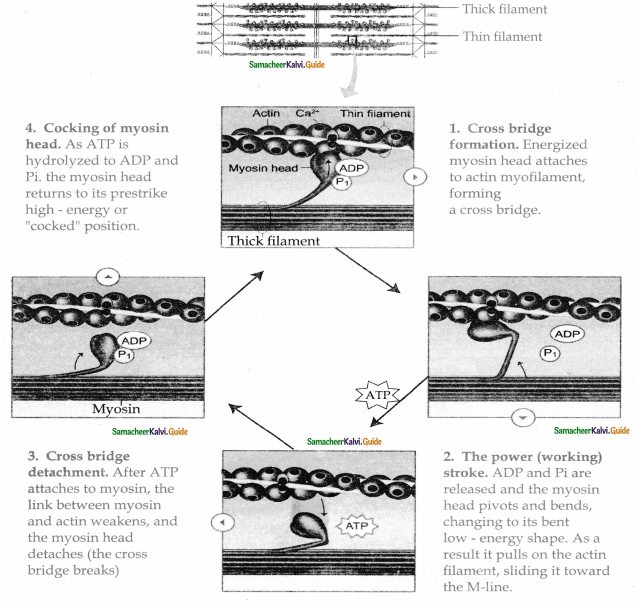
- Muscle contraction is initiated by a nerve impulse sents by the central nervous system through a motor neuron
- When the nerve impulse reaches neuromuscular junction acetylcholine is released and created action potential.
- This action potential triggers the release of calcium from the sarcoplasmic reticulum
- The released calcium ions bind to troponin on thin filaments.
- The active sites are exposed to the heads of myosin to form a cross bridge. Hence actin and myosin form a protein complex called actomyosin.
- Utilizing the energy released from the hydrolysis of ATP the myosin head rotates until it forms a 90° angle with a long axis of the filament.
- The power stroke begins after the myosin head and hinge region tilt from a 90° angle to a 45° angle.
- The cross-bridge transforms into strong high force bond which allows the myosin head to swells it.
- When the myosin head swells it pulls the attached actin filament towards the centre of the A – band.
- The myosin returns back to its relaxed state and releases ADP and phosphate ions. A Newer ATP molecule binds to the head of myosin and the cross-bridge is broken.
- At the end of each power stroke each myosin head detaches from actin then swivels back and binds to a new actin molecule to start another contraction cycle.
- The power stroke repeats many times and the thin filaments move toward the centre of the sarcomere.
- In this process, there is no change in the lengths of thick or thin filaments.
- The Z – discs attached to the actin filaments are also pulled inwards from both sides causing the shortening of the sarcomere. This process continues.
- When motor impulse stops the calcium ions are purnbed back into the sarcoplasmic reticulum results in the masking of the active sites of the actin filament and the myosin head fails to bind with the actin and causes Z – discs back to their original relaxed position.
Question 36.
What are the Benefits of regular exercise?
Answer:
- The benefits of regular exercise are:
- The muscles used in exercise grow larger and stronger.
- The resting heart rate goes down.
- More enzymes are synthesized in the muscle fibre.
- Ligaments and tendons become stronger.
- Joints become more flexible.
- Protection from a heart attack.
- Influences hormonal activity.
- Improves cognitive functions.
- Prevents obesity.
- Promotes confidence, esteem.
- Aesthetically better with a good physique.
- Overall well-being with good quality of life.
- Prevents depression, stress, and anxiety.
![]()
Part II.
11th Bio Zoology Guide Locomotion and Movement Additional Important Questions and Answers
I. Choose The Best Options
Question 1.
The pseudopodia of amoeba is formed from
a) Cytoplasm
b) Nucleoplasm
c) Sarcoplasm
d) all the above
Answer:
a) Cytoplasm
Question 2.
Where is ciliary movement taking place?
Answer:
a) Respiratory tract
b) Stomach
c) oesophagus
d) Reproductive tract
Answer:
d) Reproductive tract
![]()
Question 3.
Name the movement of spermatozoa
a) amoeboid movement
b) flagellated movement
c) Ciliary movement
d) None of the above
Answer:
b) flagellated movement
Question 4.
Muscles are made up of ………………….
a) Myocytes
b) Lymphocytes
c) adenocytes
d) leucocytes
Answer:
a) Myocytes
![]()
Question 5.
The cytoplasm of the muscle fibre is called:
a) Myofibril
b) Sarcomere
c) Sarcoplasm
d) Sarcolemma
Answer:
c) Sarcoplasm
Question 6.
Name the connective tissue which covers the entire muscle?
a) Epimycium
b) Perimycium
c) Endomyciurn
d) Mesornyscium
Answer:
a) Epimycium
![]()
Question 7.
Name the membrane which covers each fasiculi
a) Epimycium
b) Perirnycium
c) Endomyciurn
d) Mesomvscium
Answer:
b) Perirnycium
Question 8.
Name the membrane which covers each muscle fibre?
a) Epimycium
b) Perimycium
c) Endomycium
d) Mesomysciurn
Answer:
c) Endomycium
Question 9.
Match and Find the Correct Pair
1. Sarcoplasm – a) Respiratory pigment
2. Myoglobin – b) Glucose giver
3. Glycosome – c) Unit of skeletal muscle
4. Sarcomere – d) cytoplasm
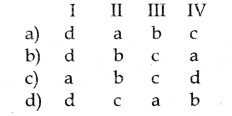
Answer:
a) I- d, II – a, III – b,IV- c
![]()
Question 10.
Find the correct and wrong statement and arrange the following statement.
1. The contraction of muscle fibres depends on the actin and myosin protein.
2. The thick muscle fibres depends on Myosin.
3. Each meromyosin molecule will have a globular head with a long arm.
4. The head of the meromyosin bears an actin-binding site and an ATP binding site.

Answer:
a) True True False True
Question 11.
Name the protein that regulates muscle contraction.
a) Tropomyosin and actin
b) Troponin and myosin
c) tropomyosin and troponin
d) None of the above
Answer:
c) tropomyosin and troponin
![]()
Question 12.
Who has proposed sliding – filaments hypothesis?
a) Andrew F. Huxley and Rolf Nieder gerke
b) Andrew F. Huxley and Nelson
c) Andrew F. Pluxley and Darwin
d) Andrew F. Huxley and Mendal
Answer:
a) Andrew F. Huxley and Rolf Nieder gerke
Question 13.
Which chemical initiates the opening of multiple gated channels in sarcolemma?
a) Epinephrine
b) Norepinephrine
c) acetylcholine
d) erythromycin
Answer:
c) acetylcholine
![]()
Question 14.
Find out the wrong pair
a) Fast – oxidative fibres – have high ATP ase activity
b) Slow – oxidative fibres – low rates of ATP ase activity
c) Oxidative fibres – less number of mitochondria
d) Red muscle fibres – oxidative fibres
Answer:
c) Oxidative fibres – less number of mitochondria
Question 15.
The skeletal system is formed from this layer!
a) Ectoderm
b) Mesoderm
c) Endoderm
d) Neuroderm
Answer:
b) Mesoderm
![]()
Question 16.
………………………… a number of bones forms the endoskeleton of man?
a) 210
b) 220
c) 206
d) 209
Answer:
c) 206
Question 17.
Hove many bones are there in the axial and appendicular skeleton?
a) 80 and 126
b) 126 and 80
c) 80 and 120
d) 80 and 118
Answer:
a) 80 and 126
![]()
Question 18.
How many bones are there in the facial and cranial bones?
a) 14 and 9
b) 14 and 8
c) 14 and 10
d) 14 and 12
Answer:
b) 14 and 8
Question 19.
Name the opening of the temporal bone
a) External auditory meatus
b) Nasal opening
c) Optic opening
d) Mouth
Answer:
a) External auditory meatus
![]()
Question 20.
Name the U-shaped single bone present at the base of the buccal cavity.
a) Palantine bone
b) Hyoid bone
c) Ethmoid bone
d) Sphenoid bone
Answer:
b) Hyoid bone
Question 21.
How many bones from the vertebral column?
a) 33
b) 32
c) 30
d) 36
Answer:
a) 33
![]()
Question 22.
Match and find the correct pair
1) Cervical vertebrae – a) – 5
2) Thoraic – b)-l
3) Pelvic bone – 0-7
4) Cocyx bone – d) -12
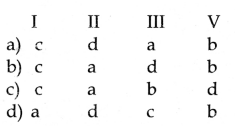
Answer:
a) I -c, II – d, III – a,IV – b
Question 23.
In which bone ………….. situated?
a) Cervical vertebra
b) thoracic vertebra
c) Pelvic vertebra
d) all the above
Answer:
d) all the above
![]()
Question 24.
Name the first vertebra?
a) Atlas
b) Maleus
c) Incus
d) Stapes
Answer:
a) Atlas
Question 25.
Name the second vertebra?
a) Atlas
b) Axis
c) Maleus
d) Stapes
Answer:
b) Axis
![]()
Question 26.
How many are the number of ribs?
a) 14 pair
b) 13 pair
c) 12 pair
d) 15 pair
Answer:
c) 12 pair
Question 27.
Match and find the correct answer
1) ribs – a) – 1, 7
2) True ribs – b) -11,12
3) False ribs – c) – Bicephalic
4) Floating ribs – d) – 8,10
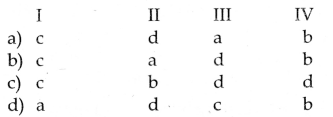
Answer:
b) I – c, II – a, III – d,IV -b
![]()
Question 28.
How many bones are there appendicular skeleton?
a) 130
b) 140
c) 126
d) 122
Answer:
c) 126
Question 29.
Which forms the appendicular skeleton?
a) Upper and hindlimbs
b) Upper limbs and thoracic bones
c) Hind and vertebral column
d) Hind and cranial bones
Answer:
a) Upper and hindlimbs
![]()
Question 30.
Name the bones which joint the axial and appendicular skeleton.
a) Clavicle bone
b) Scapula
c) Acromian process
d) None of the above
Answer:
a) Clavicle bone
Question 31.
Flow many bones are there in the upper arm.
a) 30
b) 32
c) 34
d) 36
Answer:
a) 30
![]()
Question 32.
Find the wrong pair.
a) Wrist bone – 8
b) Fore arm bones – 30
c) Facial bone -16
d) Cranial bones – 8
Answer:
c) Facial bone -16
Question 33.
Find the wrong pair
a) Palm bones – 5
b) Phalanges -14
c) Thoracic bone – 12
d) Vertebral column – 33
Answer:
d) Vertebral column – 33
![]()
Question 34.
Match and find the correct pair.
1) Cervical vertebra – a) – 12
2) Thoracic vertebra – b) – 1
3) Pelvic vertebra – c) – 7
4) Coccyx – d)-5
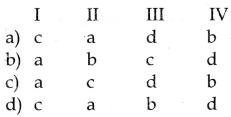
Answer:
a) I- c, II – a, III – d, IV – b
Question 35.
The oxidative skeletal muscle fibres are termed as
a) Fatty muscle fibres
b) White muscle fibres
c) red muscle fibres
d) yellow muscle
Answer:
c) red muscle fibres
![]()
Question 36.
Whether the following statement is correct or wrong find out the correct sequence.
1) Pelvic bone Ilium, Ischium, and pubis
2) Acetabulam cavity is present in the sacrum
3) The head of the thigh bone fits in the acetabulum cavity
4) The pubic bones articulate anteriorly at the pubic symphysis
Sequence:
a) 1 – True, 2 – False, 3 – True, 4 – True
b) 1 – False, 2 – False, 3 – True, 4 – True
c) 1 – False, 2 – True, 3 – True, 4 – True
d) 1 – True, 2 – True, 3 – False, 4 – True
Answer:
a) 1 – True, 2 – False, 3 – True, 4 – True
Question 37.
Which is the prominent bone of the pelvic bone?
a) Ilium
b) Ischium
c) Pubis
d) all the above
Answer:
a) Ilium
![]()
Question 38.
What is the number of hind limbs?
a) 32
b) 37
c) 30
d) 34
Answer:
c) 30
Question 39.
Name the longest bone
a) Femur
b) Humerus bone
c) Tibia
d) all the above
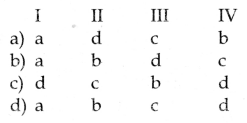
Answer:
a) I -a, II – d, III – c, IV -b
Question 40.
Match and find the correct pair.
1)Patella – a)-14
2) Tarsus – b) -5
3) Metatarsus – c) – 7 bones
4) Phalanges – d) – kneecap
Answer:
3) Metatarsus – c) – 7 bones
![]()
Question 41.
Name the membrane which covers the femur bone.
a) Periosteum
b) Endosteum
c) Osteoclast
d) Osteoblast
Answer:
a) Periosteum
Question 42.
Name the joints seen in the cranial region
a) Fibrous joints
b) Cartilagenous joints
c) Diarthroses joints
d) Synovial joints
Answer:
a) Fibrous joints
![]()
Question 43.
The Synovial fluid is seen in joints.
a) Cartilagenous joints
b) Diarthroses joints
c) Fibrous joints
d) all the above
Answer:
b) Diarthroses joints
Question 44.
Name the diseases due to the deficiency of acetylcholine.
a) Myasthenia gravis
b) Tetany
c) Duchene muscular dystrophy
d) Muscle pull
Answer:
a) Myasthenia gravis
![]()
Question 45.
Name the disease due to the deficiency of ATP
a) Muscle fatigue
b) Muscle pull
c) Muscular dystrophy
d) Tetany
Answer:
a) Muscle fatigue
Question 46.
A tear in the muscle
a) Muscle fatigue
b) Muscle pull
c) Atrophy
d) Muscular dystrophy
Answer:
b) Muscle pull
Question 47.
Name the arthritis due to aging.
a) Osteoarthritis
b) Rheumatoid arthritis
c) Gout
d) Osteoporosis
Answer:
a) Osteoarthritis
![]()
Question 48.
Osteoporosis is due to
a) Calcium
b) Sodium
c) Magnesium
d) Potassium
Answer:
a) Calcium
Question 49.
The deposition of urate crystals on the joints is called as
a) Gout
b) Rheumatoid
c) arthritis
d) Osteoporosis
Answer:
a) Gout
![]()
Question 50.
Assertion A: Acetylcholine is secreted in the Neuromuscular junction.
Reason B: If acetylcholine is not secreted there won’t be any multiple gated channels in the sarcolemma.
a) A true B wrong
b) A true B this explains the action of A
c) A wrong B true
d) A wrong B wrong
Answer:
b) A true B this explains the action of A
Question 51.
Assertion A: The upper limbs are attached to the pectoral girdles.
Reason B: The pectoral girdles are very light and allow the mobility of the hand
a) A wrong B wrong
b) A True B does not explains the A
c) A True B explains the functions of A
d) A True B wrong
Answer:
c) A True B explains the functions of A
![]()
Question 52.
Assertion A: In the pelvis bone a deep socket is present called acetabulum.
Reason B: The head of the femur bone fits in the acetabulum.
a) A True B explains the functions of A
b) A wrong B explains the functions of A
c) A True B wrong
d) B does not explains the structure of B
Answer:
a) A True B explains the functions of A
Question 53.
Assertion A: The pelvis of female is shallow wide and flexible in nature
Cause B: This helps during pregnancy.
a) A True B explains the functions of A
b) A wrong B explains the functions of A
c) A True B wrong
d) B does not explains the structure of A
Answer:
a) A True B explains the functions of A
![]()
Question 54.
Assertion A: The lower arm carries the entire weight of the body and is subjected to exceptional forces when we jump or run.
Reason B: To bear the weight of the body it has 46 bones
a) A True B True
b) A wrong B wrong
c) A True B does not explains the functions of A
d) A True B Wrong
Answer:
c) A True B does not explains the functions of A
Question 55.
Assertion A: The cranium belongs to immovable fixed joints.
Reason B: Structures of the flat skull bones are fibrous joints.
a) A True B Wrong
b) A True B explains the structure of A
c) A True B True
d) B does not explains the structure of A
Answer:
b) A True B explains the structure of A
![]()
Question 56.
Assertion A: The decreased synthesis of acetylcholine in the neuromuscular junction, causes myasthenia gravis.
Reason B: This leads to muscle fatigue weakness, paralysis.
a) A and B are True
b) A and B are wrong
c) A True B wrong
d) A wrong B True
Answer:
a) A and B are True
Question 57.
Match and arrange the sequence :
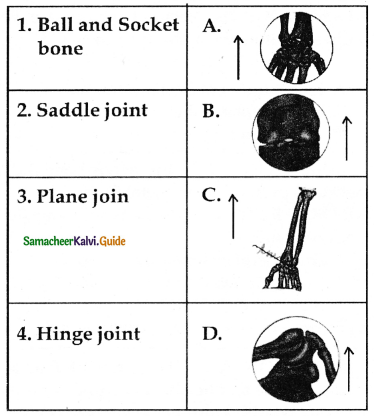
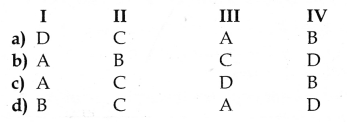
Answer:
a) I – D, II – C, III-A,IV – B
Question 58.
Match and arrange the sequence:
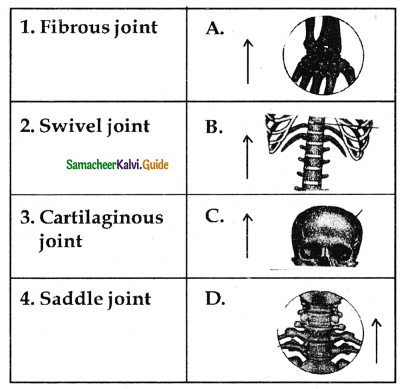
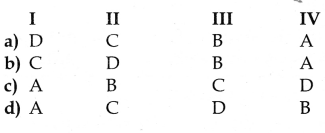
Answer:
b) I – C, II – D, III – B, IV -A
2 marks
II. Very Short answers
Question 1.
What is amoeboid movement?
Answer:
The movement of cells by streaming movements of the cytoplasm forming pseudo-podia is known as amoeboid movement, e.g., macrophages.
Question 2.
What are the types of muscles?
Answer:
- Skeletal muscle
- Visceral muscles
- Cardiac muscles
Question 3.
Name the muscle protein?
Answer:
- Actin
- Myosin
![]()
Question 4.
Name the regulatory proteins in the thin filaments.
Answer:
- Tropomyosin
- Troponin
Question 5.
Classify the muscles on the basis of their rate of shortening?
Answer:
- Fast contraction fibre
- Slow contraction fibre
Question 6.
On the basis of ATP formation, how are muscles classified?
Answer:
- Oxidative fibres
- Glycolytic fibres
![]()
Question 7.
How are muscles classified on the basis of ATP are activity?
Answer:
- Fast oxidative fibres
- Slow oxidative fibres
Question 8.
What is perimysium?
Answer:
The connective tissue covering around each fascicle is the perimysium.
Question 9.
Differentiate the oxidative fibre from the glycolytic fibre.
Answer:
| Oxidative fibre | Glycolytic fibre |
| 1. Numerous mitochondria | There are few mitochondria |
| 2. Depends on blood flow | Not depend on blood flow |
| 3. Myoglobin is present | No myoglobin |
| 4. These are known as red muscle fibres | These are called muscle fibres as white muscle fibres |
Question 10.
What is sarcoplasm?
Answer:
The cytoplasm of the muscle fibre is called the sarcoplasm.
![]()
Question 11.
What is meant by exo skeleton?
Answer:
It is a rigid hard case present outside the body of animals (eg) Cockroach.
Question 12.
What is endo skeleton?
Answer:
It is found inside the body of vertebrates. It is composed of bones and cartilages, (eg) Man.
Question 13.
What are the two types of endo skeletons?
Answer:
- Axial skeleton.
- Appendicular skeleton.
Question 14.
What are Glycosomes?
Answer:
Glycosomes are the granules of stored glycogen that provide glucose during the period of muscle fiber activity.
![]()
Question 15.
What is a brainbox?
Answer:
The cranial bones form the hard protective outer covering of the brain and called the brain box.
Question 16.
Name the ear ossicles?
Answer:
- Malleus
- incus
- stapes
Question 17.
Give notes on Jaw bones?
Answer:
- It is composed of the upper jaw which is formed of the maxilla and the lower jaw is formed of the mandible.
- The upper jaw is fused with the cranium and is immovable.
- The lower jaw is connected to the cranium and is movable.
![]()
Question 18.
Name the openings of the skull?
Answer:
- The orbits
- Nasal cavity
- Foramen magnum
Question 19.
What is meant by foramen magnum?
Answer:
- It is a large opening found at the posterior base of the skull.
- Through this opening, the medulla oblongata of the brain descends down as the spinal cord.
Question 20.
What are oxidative fibres?
Answer:
The muscle fibres that contain numerous mitochondria and have a high capacity for oxidative phosphorylation are classified as oxidative fibres. They are also called red muscle fibres.
Question 21.
Name the first two bones of the vertebral column.
Answer:
- Atlas
- Axis
![]()
Question 22.
What are the functions of the vertebral column?
Answer:
- It protects the spinal cord.
- Supports the head
- Serves as the point of attachment for the ribs and musculature of the back.
Question 23.
Give short notes on sternum?
Answer:
- The sternum is a flat bone on the mid ventral line of j the thorax.
- It provides space for the attachment of the thoracic ribs and abdominal muscles.
Question 24.
What is a hydrostatic skeleton?
Answer:
The skeleton found in soft-bodied invertebrates is called a hydrostatic skeleton. It is a fluid-filled cavity encircled by muscles, e.g., the earthworm.
![]()
Question 25.
What are true ribs?
Answer:
The first seven pairs of ribs are called true ribs. Dorsaily they are attached to the thoracic vertebrae and ventrally connected to the sternum.
Question 26.
What are false ribs?
Answer:
The 8th, 9th, and 10th pairs of ribs do not articulate directly with the sternum but joined with the seventh rib.
Question 27.
What is the sternum?
Answer:
The sternum is a flat bone on the midventral line of the thorax. It provides space for the attachment of the thoracic ribs and abdominal muscles.
![]()
Question 28.
What is meant by appendicular skeleton?
Answer:
The bones of the upper and lower limbs along with their girdles constitute the appendicular skeleton. It is composed by 126 bones.
Question 29.
White the 3 segments of lower limb.
Answer:
- The thigh
- the leg or the shank and
- the foot.
Question 30.
What is meant by acromian process?
Answer:
The scapula has a slightly elevated ridge called the spine which projects as flat expanded process called the acromion.
![]()
Question 31.
What is meant by glenoid cavity?
Answer:
Below the acromian is a depression called the glenoid cavity which articulates with the head of the humerus to form the shoulder joint.
Question 32.
What is meant by olecranon process?
Answer:
The radius and ultra bones present in the fore arm that form the pointed portion of the elbow called olecranon process.
Question 33.
What is meant by carpal tunnel?
Answer:
- There are 8 bones in the wrist arranged in two rows of four each.
- The anterior surface of the wrist has tunnel like appearance. This tunnel is termed as carpal tunnel.
Question 34.
Name the bones which forms the coxal bones.
Answer:
- Ilium
- Ischium
- Pubis
Question 35.
What is meant by pubic symphysis?
Answer:
Ventrally the two halves of the pelvic girdle meet and form the pubic symphysis containing fibrous cartilage.
![]()
Question 36.
Where calcium ion binds with the muscle fibre? Name the molecules which binds with calcium?
Answer:
- The calcium released from sarcoplasma binds with the thin fibre of the muscle.
- The released calcium binds to troponin a thin filaments.
III. Fill Up The Blanks With Suitable Options
1. Scapula – Acromian process
……………. – Bones of upper arm
2. First 7 pair of rib bones – True ribs
11 and 12th pair of ribs – …………….
3. Cervical vertebrae – 7
……………. – Lumbar bones
4. Skull bones – 22
……………. – Skull bones
5. Thick fibres – Myosin
……………. – Thin fibres
6. Amoeboid movement – Macrophage cells
……………. – Sperm cells
Answer:
- Olecronan process
- Floating ribs
- 5
- 8
- Actin
- Flagellated movement
3 marks
IV. Short answers
Question 1.
Give short notes on skeletal muscle and their covering membranes.
Answer:
- Each muscle is made up of bundles of muscle fibres called fascicle. Each muscle fibre contains rod like structures called myofibrils.
- The connective tissue covering the muscle is the epimysium.
- The covering around each fascicle is the perimysium.
- The muscle fibre is surrounded by endomysium.
Question 2.
Give the structure of a skeletel muscle fibre.
Answer:
- Each muscle fibre is thin and elongated.
- Most of them taper at one or both ends.
- Muscle fibres are surrounded by sarcolemma the cytoplasm of the muscle fibre is called the sarcoplasm.
- It contains glycosomes myoglobin and sarcoplasmic reticulum.
- Myoglobin is a red coloured respiratory pigment and glycosomes are reserved glycogen.
- Muscle fibres contain muscle protein actin and myosin.
![]()
Question 3.
Give notes on slow oxidative fibres.
Answer:
- These fibres have low rates of myosin ATP hydrolysis but have the ability to make large amounts of ATP.
- This type of fibres seen in long distance swimmers and long distance runners.
Question 4.
Give notes on fast – oxidative fibres.
Answer:
- These fibres have high myosin ATP ase activity and can make large amounts of ATP.
- They are suited for rapid action.
Question 5.
Give notes on fast glycolytic fibres.
Answer:
- These fibres have myosin ATP ase activity but cannot make as much ATP as oxidative fibres because their source of ATP is glycolysis.
- These fibres are best suited for rapid intense actions such as short sprint at maximum speed.
Question 6.
Name the facial bones.
Answer:
There are 14 facial bones.
- Pair of maxilla
- Pair of Zygomatic
- Pair of Palantine
- Pair of lacrimal
- Pair of Nasal
- Mandible or lower jaw
- Vomer
![]()
Question 7.
Give notes on fibrous joints.
Answer:
- They are immovable fixed joints in which no movement between the bones is possible.
- Sutures of the flat skull bones are fibrous joints.
Question 8.
Give notes on cartilaginous joints.
Answer:
They are slightly movable joints in which the joint surface are separated by a cartilage and slight movement is only possible.
Question 9.
Give notes on synovial joints.
Answer:
They are freely movable joints the articulating bones are separated by a cavity which is filled with synovial fluid.
![]()
Question 10.
Give notes on myasthenia gravis.
Answer:
- It is an auto immune disorder affecting the action of acetylcholine at neuro muscular junction leading to fatique.
- Weakening and paralysis of skeletal muscles.
- Acetylcholine receptors on the sarcolemma are blocked by antibodies leading to weakness of muscles.
- When the disease progresses it can make chewing swallowing talking and even breathing difficult.
Question 11.
Give notes on muscle fatique.
Answer:
- It is the inability of a muscle to contract after repeated muscle contraction.
- This is due to lack of ATP and accumulation of lactic acid by anaerobic break down of glucose.
Question 12.
Give notes on Atrophy of muscles.
Answer:
- A decrease in the activity of muscles results in the atrophy of muscles.
- There is a reduction in the size of the muscle and makes the muscle to become weak which occurs with lack of usage as in chronic bed ridden patients.
Question 13.
What is meant by muscle pull?
Answer:
- Muscle pull is actually a muscle tear.
Atraumatic pulling of the fibres produces a tear known as sprain. - This can occur due to sudden stretching of muscle beyond the point of elasticity.
- Back pain is a common problem caused by muscle pull due to improper posture with static sitting for long hours.
![]()
Question 14.
What is meant by muscular dystrophy?
Answer:
- The group of diseases collectively called the muscular dystrophy are associated with the progressive degeneration of skeletel muscle fibres weakening the muscles and leading to death from lung or heart failure.
- (eg) Duchene muscular dystrophy.
Question 15.
What is meant by skeletel muscle glycogen analysis?
Answer:
- This is used to measure an athlete’s muscle glycogen.
- Muscle glycogen provides the main source of energy during anaerobic exercise.
- A single glycogen molecule may contain 5000 glucose molecules.
Question 16.
Give notes on osteoporosis?
Answer:
- It occurs due to deficiency of vitamin D and hormonal imbalance.
- It causes rickets in children and osteomalasia in adult females.
- The bones become soft and fragile.
- It can be minimized with adequate calcium intake vitamin D intake and regular physical activities.
Question 17.
What is carpal tunnel syndrome?
Answer:
- The narrow passage bounded by bones and ligaments in the wrist get narrowed and pinches the median nerve.
- This syndrome is mostly seen among the clerks, software professional and people who constantly play or text in mobile phones.
5 Marks
V. Give Detailed Answers
Question 1.
Describe about the different types of movements with examples.
Answer:
Types of Movements :
- Amoeboid movements
- Ciliary movements
- Flagellar movements
- Muscular movements
1. Amoeboid movements:
Cells such as macrophages exhibit amoeboid movement for engulfing pathogens by pseudopodia formed by the streaming movement of the cytoplasm.
2. Ciliary movements :
This type of movement occurs in the respiratory and genital passages.
3. Flagellar movement:
This type of movement occurs in the cells which are having flagella or whiplike motile organels. (eg) Sperm cells.
4. Muscular movement:
The movement of hands legs jaws are caused by the contraction and relaxation of the muscle.
![]()
Question 2.
Describe the structure of sarcomere.
Answer:
- The unit of the skeletal muscle is sarcomere A sarcomere is the region of a myofibril between two successive z – discs.
- It contains an ‘A’ band with a half I band which are perfectly aligned with one another.
- This type of arrangement gives the cell a striated appearance.
- Each dark band has a lighter region in its middle called the M – zone.
- Each H – zone is bisected vertically by a dark line called the M – line.
- The I bands have a darker mid line area called the z – disc.
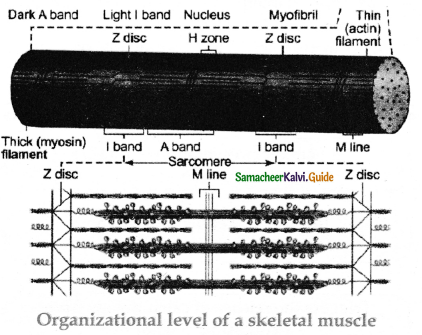
- Inside the sarcomere two types of filaments are present namely the thick filaments and thin filaments.
- The thick filaments extend the entire length of the A band, the thin filaments extend across the I band and partly into the A – band.
- The invagination of the sarcolemma forms transverse (T- tubules) tubules and they penetrate into the junction between the A and I bands.
Question 3.
Describe the structure of muscle protein.
Answer:
Contraction of the muscle depends on the presence of contractile proteins such as actin and myosin.
Myosin fibre:
- The thick filaments are composed of the protein myosin.
- Each myosin molecule is made up of monomer called meromyosin.
- The meromyosin have a globular head with a j short arm and a tail.
- The short arm have heavy meromyosin and the tail portion have the light meromyosin.
- The head bears an actin – binding site and an ATP binding site
- It also contains ATP ase enzyme that split ATP to generate energy for the contraction of muscle.
Actin filament:
- Actin has polypeptide subunits called globular actin or G – actin and filamentous form F – actin.
- Each thin filament is made of two F – actins helically wound to each other.
- Each F – actin is a polymer of monomeric G – actins, It also contains a binding site for myosin.
- The thin filament contain several regulatory protein like tropomyosin, troponin, which help in regulating the contraction of muscles along with actin and myosin.
Thick filament:
Each thick filament consists of many myosin molecules whose heads produce at opposite ends of the filament Portion of a thick filament
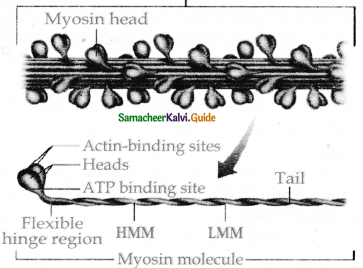
Thin filament:
A thin filament consists of two strands of actin subunits twisted into a helix plus two types of regulatory proteins (troponin and tropomyosin) Portion of a thin filament.
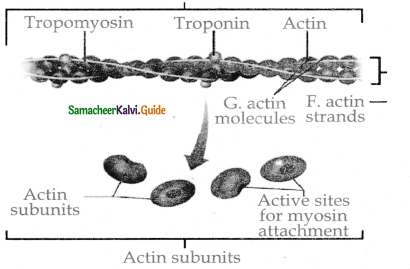
Question 4.
Give the schematic representation of muscle contraction.
Answer:
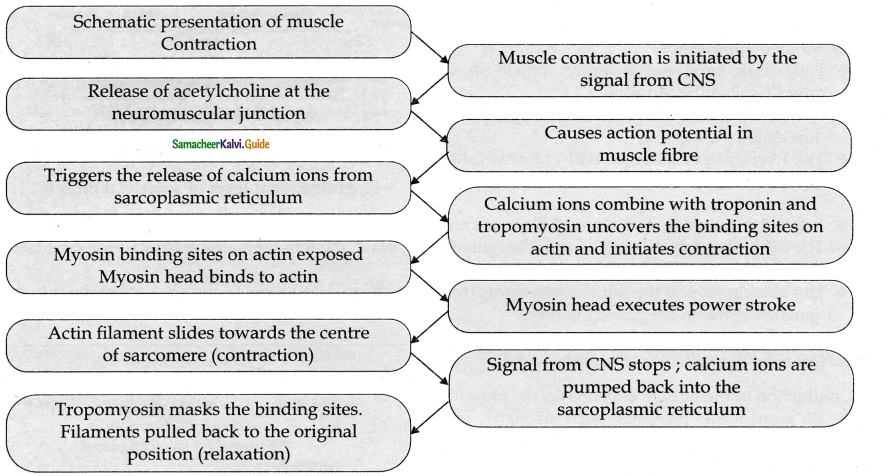
Question 5.
Give the four important features of skeletal muscles.
Answer:
- Excitability :
Based on the chemical and electrical excitation the muscles contracts. - Contractility:
It is the ability of the muscle which gives movement to the attached organs. - Conductivity:
The excitation at one part of the muscle is connected to the other part of the muscle. - Elasticity :
The ability of the muscle to returns to its original position after the extension of the muscles.
![]()
Question 6.
Explain the bones that form the skull?
Answer:
The skull is composed of two sets of bones – cranial and facial bones. It consists of 22 bones of which 8 are cranial bones and 14 are facial, bones. The cranial bones form the hard protective outer covering of the brain and called the brain box. The capacity of the cranium is 1500 cm3.
These bones are joined by sutures which are immovable. They are paired parietal, paired temporal and individual bones such as the frontal, sphenoid, occipital and ethmoid. The large hole in the temporal bone is the external auditory meatus. In the facial bones maxilla, zygomatic, palatine, lacrimal, nasal are paired bones whereas mandible or lower jaw and vomer are unpaired bones. They form the front part of the skull.
A single U-shaped hyoid bone is present at the base of the buccal cavity. It is the only bone without any joint. Each middle ear contains three tiny bones- malleus, incus, and stapes collectively are called ear ossicles. The upper jaw is formed of the maxilla and the lower jaw is formed of the mandible.
The upper jaw is fused with the cranium and is immovable. The lower jaw is connected to the cranium by muscles and is movable. The most prominent openings in the skull are the orbits and the nasal cavity. The foramen magnum is a large opening found at the posterior base of the skull. Through this opening, the medulla oblongata of the brain descends down as the spinal cord.
Question 7.
Give an account of vertebral column.
Answer:
- It consists of 33 serially arranged vertebrae which are interconnected by a cartilage known as inter vertebral disc.
- The vertebral column extends from the base of the skull to the pelvis and forms the main framework of the trunk.
It has five major regions, they are
- Cervical – 7
- Thoracic vertebrae -12
- Lumbar vertebrae – 5
- Sacrum – 5 sacral vertebrae found in the infant which are fused to form one bone in the adult.
- Coccyx – 1 – 4 Coccy geal vertebrae found in the infant which are fused to form one bone in the adult.
Question 8.
Give an account of the ribcage.
Answer:
- There are 12 pairs of ribs.
- Each rib bone is connected dorsally to the vertebral column and ventrally to the sternum.
- It has two articulation surfaces on its dorsal end called bicephalic.
- The first 7 pairs of ribs are called true ribsorvertebro – sternal ribs.
- Dorsally they are attached to the thoracic vertebrae and ventrally connected to the sternum with the help of hyaline cartilages.
- The 8th, 9th and 10th pairs of ribs do not articulate directly with the sternum but joined with the cartilaginous part of the seventh rib.
- These are called false ribs or vertebro – chondral ribs.
- The last 11th and 12th pairs of ribs are not connected ventrally.
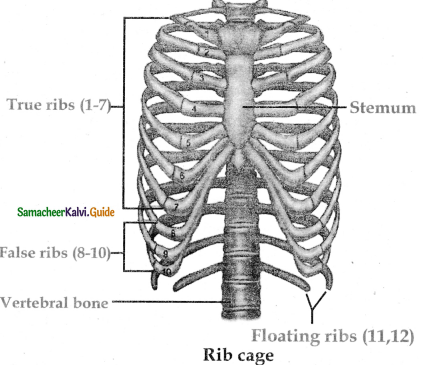
- They are called as floating ribs or vertebral ribs.
- Thoracic vertebrae ribs and sternum form the rib cage.
![]()
Question 9.
Give an account of the pectoral girdle?
Answer:
- The upper limbs are attached to the pectoral girdles.
- These are very light and allow the upper limbs a degree of mobility not seen any where else in the body.
- The girdle is formed of two halves.
- Each pectoral girdle consists of a clavicle or collar bone and a scapula.
- The scapula is a large triangular bone situated in the dorsal surface of the ribcage between the second and seventh ribs.
- It has a elevated expanded process called the acromion.
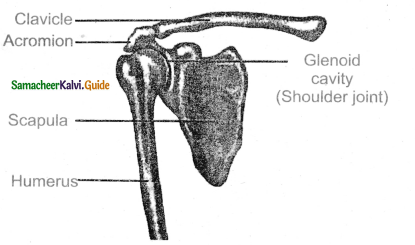
- The clavicle articulates this process.
- Below the acromion is a depression called the glenoid cavity which articulates with the head of the humerus to form the shoulder joint.
- Each clavicle is a long slender bone with two curvatures which lie horizontally and connect the axial skeleton with the appendicular skeleton.
Question 10.
Describe the structure of the upper limb.
Answer:
- The upper limb consists of 30 separate bones and is specialized for mobility.
- The region between the shoulder and elbow is the humerus.
- The head of humerus articulates with the glenoid cavity of the scapula and forms the shoulder joint.
- The distel end of humerus articulates with the two fore arm bones the radius and ulna
- Olecranon process is situated at the upper end of the ulna which forms the pointed portion of the elbow.
- The hand consists of carpals metacarpals and phalanges.
- Carpals the wrist bones 8 in number are arranged in two rows of four each and form a tunnel termed as carpal tunnel.
- Meta carpals the palm bones are 5 in number and phalanges the digit bones are 14 in number.
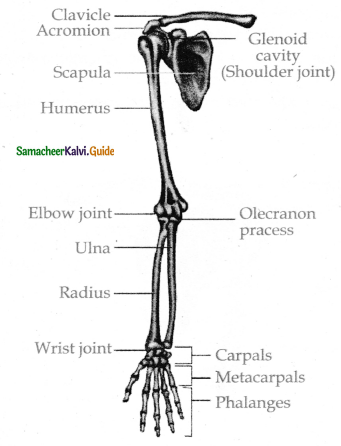
Question 11.
Give an account of pelvic girdle.
Answer:
- The pelvic girdle is a heavy structure specialised for weight-bearing.
- It is composed of two hib bones called coxal bones that secure the lower limbs to the axial skeleton.
- Together with the sacrum and coccyx the hib bones form the basin like bonypelvis.
- Each coxal bone consists of three fused bones ilium, ischium, and pubis.
- At the point of fusion of these three bones forms a deep hemispherical socket called the acetabulum present on the lateral surface of the pelvis.
- It receives the head of the femur at hip joint and helps in the articulation of the femur.
- Ventrally the two halves of the pelvic girdle meet and form the pubic symphysis containing fibrous cartilage.
- The ilium is the superior flaring portion of the hip bone. Each ilium forms a secure joint with the sacrum posteriorly.
- The ischium is a curved bar of bone. The ‘V’ shaped pubic bones articulate anteriorly at the pubic symphysis.
- The pelvis of male is deep and narrow with larger heavier bones and the female is shallow wide and flexible in nature and this helps during pregnancy which is influenced by female hormones.
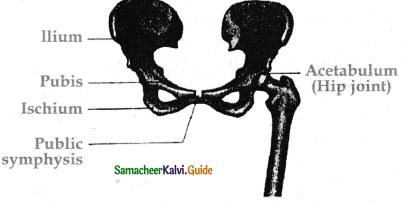
Question 12.
Give an account of the lower limb.
Answer:
- The lower limb consists of 30 bones which carries the entire weight of the erect body and is subjected to exceptional forces when we jump or run.
- The bones of the lower limbs are thicker and stronger than the upper limbs.
- Each lower limb consists of the thigh, the leg or the shank and the foot.
- The femur is the strongest and longest bone of the body.
- The head of femur articulates with the acetabulum of the pelvis to form the hip joint.
- The tibia and fibula form the skeleton of the shank.
- A thick triangular patella forms the knee cap which protects the knee joint arteriorly and improves the leverages of thigh muscles acting across the knee.
- The foot includes the bones of ankle the tarsus (7) the metatarsus (5) and the phalanges or toe ebones. (14)
- The foot supports our body weight and acts as a lever to propel the body forward while walking and running.
- The phalanges of the foot are smaller than those of the fingers.
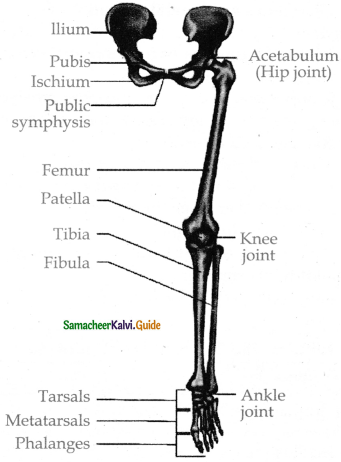
![]()
Question 13.
Give an account of a structure of a typical long bone.
Answer:
- The typical long bone has a diaphysis, epiphyses and membranes.
- A tubular diaphysis or shaft forms the long axis of the bone and has a central medullary cavity.
- The epiphyses are the bone ends.
- Compact bone forms the exterior of epiphyses and their interior contains spongy bone with red marrow.
- The region where the diaphysis and epiphysis meet is called metaphysis.
- The external surface of the entire bone except the joint surface is covered by a double-layered membrane called the periosteum.
- The outer fibrous layer is dense irregular connective tissue.
- The inner osteogenic layer consists of osteoblasts cell. ( bone-forming cells) and osteoclasts cells (E bone – destroying cells)
- There are primitive stem cells osteogenic cells that give rise to the osteoblasts.
- The periosteum is richly supplied with nerve fibres lymphatic vessels and blood vessels.
- Internal bone surfaces are covered with a delicate connective tissue membrane called the endosteum It also contains osteoblasts and osteoclasts cells.
- Between the epiphysis and diaphysis growthplate or epiphyseal plate is present.
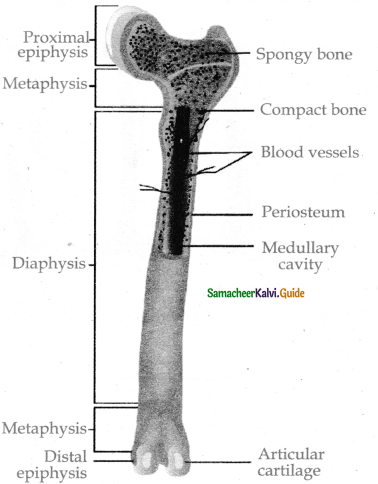
![]()
Question 14.
Write a short note on Rib cage?
Answer:
There are 12 pairs of ribs. Each rib is a thin flat bone connected dorsally to the vertebral column and ventrally to the sternum. It has two articulation surfaces on its dorsal end, hence called bicephalic.
The first seven pairs of ribs are called ‘true ribs or vertebro-stemal ribs. Dorsally they are attached to the thoracic vertebrae and ventrally connected to the sternum with the help of hyaline cartilages.
The 8th, 9th and 10th pairs of ribs do not articulate directly with the sternum but joined with the cartilaginous (hyaline cartilage) part of the seventh rib. These are called ‘false ribs’ or vertebro-chondral ribs.
The last 11th and 12th pairs of ribs are not connected ventrally. Therefore, they are called as ‘floating ribs’ or vertebral ribs. Thoracic vertebrae, ribs and sternum together form the ribcage. Rib cage protects the lungs, heart, liver and also plays a role in breathing.
Question 15.
Tabulate the differentiate of joints man
Answer:
| Pivot joint | between atlas and axis |
| Gliding joint | between the carpals |
| Saddle joint | between the carpal and meta carpal |
| Ball and socket joint | between humerus and pectoral gridle |
| Hinge joint | Knee joint |
| Condyloid or Angular or Ellipsoid | Joint between radius joint and carpal |
Question 16.
Draw the diagram of different types of fracture and arrange them.
Answer:
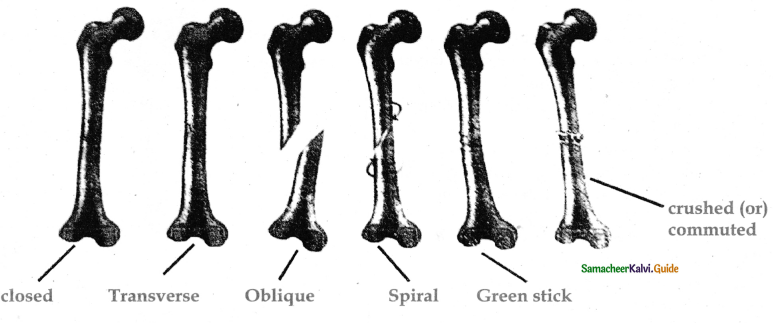
Question 17.
Bones of the skeletal system. Table: 1 Bones of skeletal system
Answer:
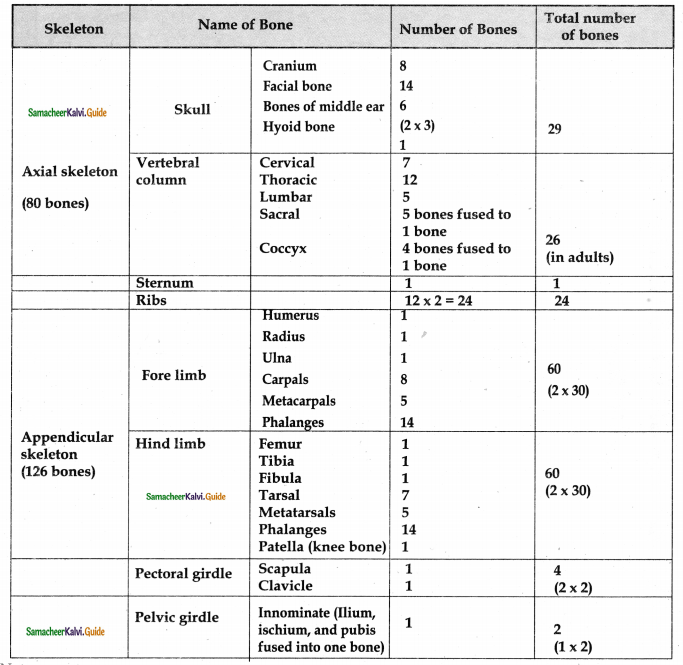
Notes:
- The strongest muscle in the human: Massetter in cheeks
- The smallest muscle in the human: Middle ear in stapedius
- Well moving muscle: Tongue
- The largest muscle in the human: Buttock in Glutens Maximus
- The longest muscle in the human : Hip to knee (sartorius)
- Total number of bones is adults = 206
![]()
Question 18.
Explain the basic categories of exercise and physical activity?
Answer:
Exercise and physical activity fall into four basic categories. Endurance, strength, balance, and flexibility. Endurance or aerobic activities increase the breathing and heart rate. They keep the circulatory system healthy and improve overall fitness.
Strength exercises make the muscles stronger. They help to stay independent and cany out everyday activities such as climbing stairs and carrying bags.
Balance exercises help to prevent falls which is a common problem in older adults. Many strengthening exercises also improve balance.
Flexibility exercises help to stretch body muscles for more freedom of joint movements.